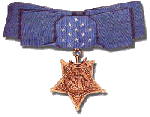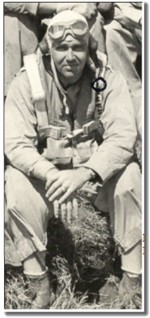|

Edward H. "Butch"
O'Hare
Congressional Medal of
Honor Citation
Butch in a squadron Photo at Punnene, Maui in July 1, 1943.

 |
Rank and organization:
Lieutenant, U.S. Navy. Born: 13 March 1914, St. Louis, Mo. Entered service at: St. Louis, Mo.
Other Navy awards:
Navy Cross, Distinguished Flying Cross with 1 gold star.
Citation:
"For conspicuous gallantry and intrepidity in aerial combat, at grave risk of his life above and beyond
the call of duty, as section leader and pilot of Fighting Squadron 3 on 20 February 1942.
Having lost the assistance of his teammates, Lt. O'Hare interposed his plane between his ship and
an advancing enemy formation of 9 attacking twin-engine heavy bombers.
Without hesitation, alone and unaided, he repeatedly attacked this enemy formation, at close range
in the face of intense combined machinegun and cannon fire.
Despite this concentrated opposition, Lt. O'Hare, by his gallant and courageous action, his extremely
skillful marksmanship in making the most of every shot of his limited amount of ammunition, shot down 5 enemy bombers
and severely damaged a sixth before they reached the bomb release point.
As a result of his gallant action - one of the most daring, if not the most daring, single action
in the history of combat aviation - he undoubtedly saved his carrier from serious damage."
Franklin Delano Roosevelt,
President of the United States of America.
The Story behind the Citation and Award..
World War II produced many heroes. One such man was Lieutenant Commander Butch O'Hare. He was a fighter
pilot assigned to the aircraft carrier Lexington in the South Pacific. One day his entire squadron was sent on
a mission. After he was airborne, he looked at his fuel gauge and realized that someone had forgotten to top off
his fuel tank. He would not have enough fuel to complete his mission and set back to his ship. His flight leader
told him to return to the carrier. Reluctantly he dropped out of formation and headed back to the fleet. As he
was returning to the mother ship, he saw something that turned his blood cold.
A squadron of Japanese bombers were speeding their way toward the American fleet. The American fighters
were gone on a sortie and the fleet was all but defenseless. He couldn't reach his squadron and bring them back
in time to save the fleet. Nor, could he warn the fleet of the approaching danger. There was only one thing to
do. He must somehow divert them from the fleet. Laying aside all thoughts of personal safety, he dove into the
formation of Japanese planes.
Wing-mounted 50 calibers blazed as he charged in, attacking one surprised enemy plane and then another.
Butch weaved in and out of the now broken formation and fired at as many planes as possible until finally all his
ammunition was spent. Undaunted, he continued the assault. He dove at the planes, trying to at least clip off a
wing or tail, in hopes of damaging as many enemy planes as possible and rendering them unfit to fly. He was desperate
to do anything he could to keep them from reaching the American ships. Finally, the exasperated Japanese squadron
took off in another direction.
Deeply relieved, Butch O'Hare and his tattered fighter limped back to the carrier. Upon arrival he
reported in and related the events surrounding his return. The film from the camera mounted on his plane told the
tale. It showed the extent of Butch's daring attempt to protect his fleet. He had destroyed five enemy bombers.
That was on February 20, 1942, and for that action he became the Navy's first Ace of World War II and the first
World War II Naval Aviator to be awarded the Medal of Honor.
A year later he was killed in aerial combat at the age of 29. His home town would not allow the memory
of that heroic action to die. And today, O'Hare Airport in Chicago is named in tribute to the courage of this great
man. So the next time you're in O'Hare visit his memorial with his statue and Medal of Honor. It is located between
terminal 1 and 2.
O'Hare International Airport is named for Lt. Cmdr. Edward "Butch" O'Hare, a World War
II fighter pilot from Chicago known as one of the greatest heroes in naval history. O'Hare's incredible courage
and effective leadership inspired Col. Robert H. McCormick, publisher of the Chicago Tribune, to lead the charge
to rename the Chicago-area airport (formerly named Orchard Field) in O'Hare's honor in 1949.
O'Hare's Story of Bravery..
On February 20, 1942, the U.S.S. Lexington was approximately 400 miles from its destination of Rabaul
Harbor in the Solomon Islands when the aircraft carrier was spotted by enemy patrols. Lt. O'Hare and another pilot
picked up the formation of enemy fighters closing in on the Lexington and immediately ordered an attack. Within
moments, his wingman's guns jammed, and without assistance, O'Hare carried out a swift and decisive strike on the
enemy fighters, saving the U.S.S. Lexington and his fellow pilots.
For his inspiring leadership and gallant fighting spirit, O'Hare received the U.S. Congressional
Medal of Honor. President Franklin D. Roosevelt called the mission that saved the Lexington, "one of the most daring, if not the most daring, single action
in the history of combat aviation."
For his heroic actions in battles near Marcus Island on August 31, 1943 and near Wake Island on October
5, 1943, O'Hare was awarded the Distinguished Flying Cross and the Gold Star, some of the Navy's highest honors.
Just one month later, in November 1943, O'Hare volunteered to lead his squadron on a daring mission
to conduct the first-ever Navy nighttime fighter attack from an aircraft carrier. After receiving the go-ahead
from his Admiral, O'Hare led the first fighter section to intercept a large force of enemy torpedo bombers, but
his plane was lost in enemy action and never found. He was just 29 years old.
On November 27, 1944, Butch O'Hare was declared dead. The U.S. Navy recognized his unparalleled bravery
with the Navy Cross award. He is also listed in the Navy Memorial Foundation.
The Butch O'Hare Fighter..
In his Congressional Medal of Honor winning flight to save the U.S.S. Lexington, Butch O'Hare flew
an F4F-3 Wildcat.
The Wildcat was an extremely basic flying machine - it had hand-cranked landing gear made primarily of bicycle
chains and sprockets, manually-charged guns, vacuum-powered wing flaps, a simple electrical system, and no hydraulics.
Despite its simple design, it was a tough plane with a high degree of pilot survivability in crashes. The Wildcat
earned for the Grumman Aircraft Factory, where it was built, the nickname "The Iron Works."
An original F4F-3 Wildcat was recovered from Lake Michigan by the United States Navy and donated to the Air Classics
Museum. The plane was restored to replicate the one flown by Butch O'Hare. Sponsored by the City of Chicago and
McDonald's Corporation, the recovered F4F-3 Wildcat is exhibited in Terminal Two at the West end of the ticketing
lobby to honor the extraordinarily heroic feats of O'Hare International Airport's namesake.
Information courtesy of 'The Medal of Honor' Website.
In 1990, members of Butch O'Hare's Squadron, Fighting Six
(VF-6) assembled for the first time since the end of WWII to honor their former Commander and Comrade in Arms Edward
"Butch" O'Hare with a Memorial Plaque. Please visit there
to take part in this Memorable event.
"For those who fought for it...
freedom has a flavor the protected will never know!"
|